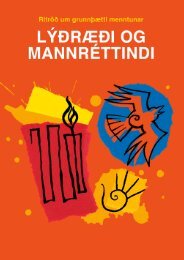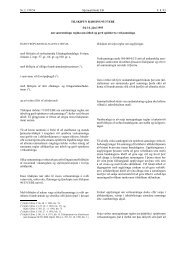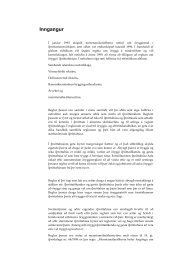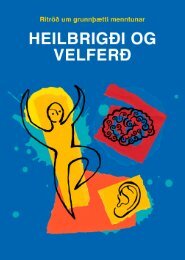Arts and Cultural Education in Iceland : Professor Anne Bamford
Arts and Cultural Education in Iceland : Professor Anne Bamford
Arts and Cultural Education in Iceland : Professor Anne Bamford
You also want an ePaper? Increase the reach of your titles
YUMPU automatically turns print PDFs into web optimized ePapers that Google loves.
1.10 Compulsory Schools<br />
‣ Almost all compulsory schools have specialist visual arts, textile <strong>and</strong> woodwork<br />
teachers <strong>and</strong> facilities with the majority of schools hav<strong>in</strong>g specialist music teachers<br />
<strong>and</strong> some dance <strong>and</strong> drama.<br />
In most schools, children get specialist lessons <strong>in</strong> arts <strong>and</strong> cultural education as a compulsory<br />
part of education from grades 2-8. While the way this is done can vary from one school to the<br />
next, the general picture <strong>in</strong>cludes specialist lessons <strong>in</strong> art (f<strong>in</strong>e arts, draw<strong>in</strong>g, pa<strong>in</strong>t<strong>in</strong>g etc); wood<br />
<strong>and</strong> metal work; textiles <strong>and</strong> sew<strong>in</strong>g; cook<strong>in</strong>g; <strong>and</strong> computers.<br />
Additionally the majority of schools have specialist music lessons <strong>and</strong> some also have<br />
specialist dance lessons (though these are generally <strong>in</strong> a ‘block’ rather than spread throughout<br />
the year. In the majority of cases, these lessons are taught by specialist tra<strong>in</strong>ed teachers <strong>in</strong><br />
especially equipped, studio style classrooms. In most cases, classes are split. So for example, half<br />
the class might go to cook<strong>in</strong>g, while the other half goes to wood work. After half the school year<br />
(usually around Christmas) the classes swap <strong>and</strong> experience the other arts form. Lessons are<br />
usually once a week for each art form <strong>and</strong> tend to be 2x40 m<strong>in</strong>ute lessons per week.<br />
A shortage of music <strong>and</strong> dance teachers means that these are less common <strong>in</strong> school than<br />
the other art forms. To counteract this, a number of schools have outside providers who come <strong>in</strong><br />
to offer music <strong>and</strong> dance lessons, <strong>in</strong>clud<strong>in</strong>g percussion lessons. These may be private artists or<br />
practitioners or might come from the music school. The teachers from the music school are<br />
more likely to come to younger children (who are too young to start after school music school)<br />
than to fill any ‘gaps’ <strong>in</strong> music education <strong>in</strong> the older classes. Most schools also get some other<br />
‘supplementary’ arts professional dur<strong>in</strong>g the year. For example, one school employed a Director<br />
to work with pupils <strong>in</strong> year 8-10 to produce the annual school play.<br />
1.11 Upper secondary schools<br />
‣ Pupils <strong>in</strong> secondary school have a wide choice of electives.<br />
‣ Pupil generated arts <strong>and</strong> cultural activities are popular <strong>and</strong> can attract additional<br />
credit po<strong>in</strong>ts.<br />
Upper secondary schools are not compulsory, but everyone to the age of 18 has the right to<br />
upper secondary education. The typical course length is four years, for students aged between<br />
16 <strong>and</strong> 20, though students of any age can attend. Secondary schools (gymnasia) are divided <strong>in</strong>to<br />
four types:<br />
grammar schools—offer<strong>in</strong>g four-year long programmes of study, end<strong>in</strong>g with<br />
matriculation exams;<br />
vocational schools—theoretical <strong>and</strong> practical courses <strong>in</strong> various trades;<br />
comprehensive schools—offer<strong>in</strong>g a mixture of courses, has qualities of both a grammar<br />
school <strong>and</strong> an <strong>in</strong>dustrial-vocational <strong>in</strong>stitution, <strong>in</strong> addition to specialised vocational<br />
programmes;<br />
specialised vocational schools—programmes of study for specific trades <strong>and</strong> careers.<br />
Several secondary schools <strong>in</strong> Icel<strong>and</strong> have an art specialism or arts options. The follow<strong>in</strong>g<br />
vignette is one such example:<br />
Vignette 1.11.1 We are very proud of this department<br />
34


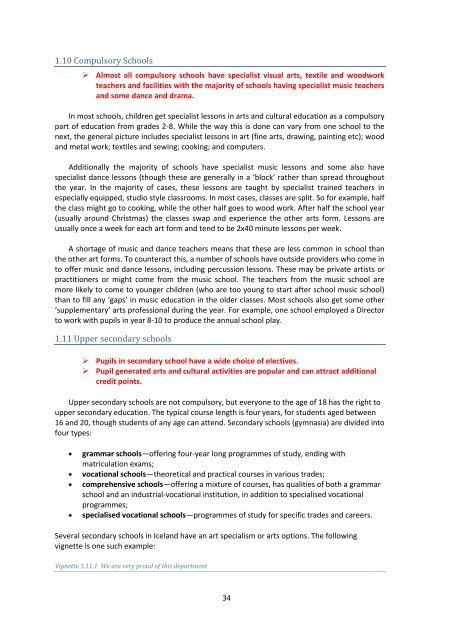
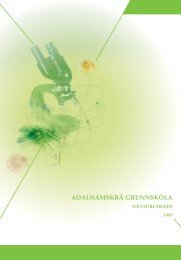
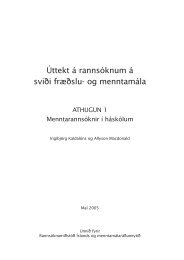

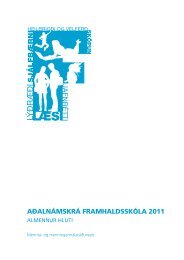
![Aðalnámskrá tónlistarskóla : rytmÃsk tónlist [Eingöngu á rafrænu formi]](https://img.yumpu.com/50843672/1/184x260/aaalnamskra-tanlistarskala-rytma-sk-tanlist-eingangu-a-rafranu-formi.jpg?quality=85)
